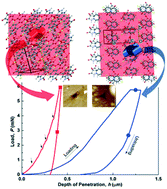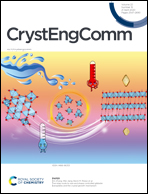Probing the distinct nanomechanical behaviour of a new co-crystal and a known solvate of 5-fluoroisatin and identification of a new polymorph†
Abstract
New crystalline forms (a polymorph and a co-crystal) and a previously reported solvate of the parent compound 5-fluoroisatin have been characterized by thermal, structural, and computational methods. The mechanical responses (hardness, H, and elastic modulus, E) of the co-crystal and the solvate have been characterized using nanoindentation experiments on the major faces. Results show that H and E of the solvated form of the molecule are 11 and 13 fold higher than those of the co-crystal, respectively. Energy decomposition analyses have been performed on these crystal structures to understand the primary building blocks and the role of different intermolecular interaction energies in the observed nanomechanical properties. These suggest that a nearly similar layered interaction topology of molecules is present in both the co-crystal and the solvated form. Interestingly, the presence of relatively strong interlayer interactions of molecules in the solvate prevents long-range molecular layer migration, which minimizes the scope for plastic deformation in comparison to the co-crystal.

- This article is part of the themed collection: Introducing the CrystEngComm Advisory Board and their research


 Please wait while we load your content...
Please wait while we load your content...